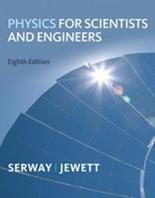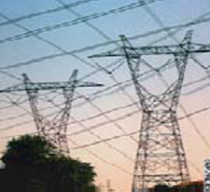Goucher CollegeDepartment of Physics and AstronomyGeneral Physics IIPHY.126Spring 2013Click here for a class scheduleClick here for a homework schedule
· Instructor Dr. Sasha Dukan Please respect this schedule and make appointment to see me at other times. Class will be held on Monday, Wednesday and Friday from 1:30 pm to 3:20 pm in HS B26.
· Course Assistant Mr. Semyon Ginzburg Office: Hoffberger B19 Phone: 410-337-6321 email: sginzbur@goucher.edu
· Course SI
· Textbook Serway and Jewett: Physics for Scientists and Engineers, 8th edition, Thomson Brooks/Cole.
· Course Description Physics 126 is a second semester of a calculus based General Physics course designed for students majoring in the physical sciences or engineering. The main objective of the course is to introduce students to basic concepts of Mechanical Waves, Electricity and Magnetism and Optics. The course will use calculus as a tool in developing universal language of physics, but emphasis will be on student's intuitive understanding and visualization of various phenomena in nature governed by physical laws.
· Course Goals The course goals are for each student to:
· learn the physical principles of electromagnetism, waves and optics, · evaluate the validity and limitations of scientific theories behind the topics studied, · understand relevance and application of electromagnetism, waves and optics to everyday life · understand the experimental or computational (i.e. laboratory) method to test a scientific hypothesis and interpret the data from these tests
· Learning Outcomes By the end of the course, the student will be able to:
· explain the physical concept of electromagnetism, waves and optics, · solve multi-step physics problems using algebraic and/or calculus methods, · identify phenomena and technologies in the world around us that are based on the physical principles studied, · collect and analyze experimental data statistically or graphically and write a concise laboratory report.
· Instructional Methods Students have an opportunity to learn in depth the basic concepts of classical physics from a variety of sources during the semester, including: ̃ Assigned textbook readings ̃ Classroom lectures and discussions ̃ Frequent computer demonstrations and simulations ̃ Homework assignments on GoucherLearn and presentation of solutions ̃ On-line weekly quizzes on GoucherLearn ̃ In-class problem solving exercises ̃ In-class tests ̃ Hands-on activities and laboratory projects ̃ Discussions with me outside of the class
Classroom time will be mostly centered around the discussions and student participation is required. I do not keep attendance but unexcused absence will be noticed.
· Responsibilities of Students In order to get the most out of this course: ̃ Attend each class, arrive on time and come prepared . Read an assigned sections of the textbook before coming to the class to familiarize yourself with notation and topic. Read the relevant section of the textbook with comprehension before attempting to solve homework problems. ̃ Participate in class by paying close attention to what is presented and offering suggestions or corrections when you think something that is presented is incorrect or confusing. ̃ Work on and try to complete all homework problems on time. You are encouraged to discuss problems with your peers but, if at all possible, complete these problems without assistance from anyone else. This way you will truly understand the problem and will be prepared for the exams. ̃ Make your work neat and carefully organized. If I can’t follow your solution then you will not receive a full credit. ̃ Come talk to me outside of the class frequently. Asking for help or hints with solving problems, or asking for clarification of the lectures or the textbook demonstrates your interest in the subject.
· Interactive Classroom Lectures will not simply involve following the textbook, there will be many demonstrations to aid in understanding of physics concepts. Lab work in this course will be integrated with the lectures, so that you can discover new physics concepts by direct experimentation. There will be an extensive use of multimedia presentations in order to enhance classroom experience and connect covered material to everyday life. Computers are fully integrated in the classroom both through laboratory experiments and interactive computer simulations. A significant amount of time will be spent in developing problem solving strategies which are necessary in learning and understanding physics principles. Problems worked in the lectures will occasionally appear on the exams, so it is in your best interest to regularly attend the lectures. GoucherLearn will serve as an on-line board where you can find updated information related to the course as well as your weekly homework assignments and quizzes.
· Laboratory Experiments There will be eight laboratory projects for which up to eight laboratory reports will be assigned and graded. The report is due a week after a laboratory project has been competed. The whole idea of a laboratory report is to describe what you have done, analyze data taken and give results and conclusions derived from them in a concise written form. It is extremely important that you are organized and clear in your presentation. Reports which are impossible to follow will be returned to be rewritten. The general form of your report should be as follows: · Title-name of the experiment · Abstract-An executive summary of your report which should be written after all other sections of the report but positioned as second part of the report. · Statement of Purpose- What do you hope to accomplish in this laboratory? · Background-physical principles behind the experiment. These are usually what you have studied in the lecture before the experiment. · Procedure-brief description of the experimental procedure · Results-the most important part of your report. Contains experimental data presented in tabulated form with proper units and uncertainties in measurement. Also contains your calculations of the related parameters in the experiment. · Conclusions-contains the discussion of obtained results and your statement about the experiment. Did the experiment produce the expected results, i.e. do your experimental results agree with the physical laws you learned in class? If not, what are the possible sources of discrepancy? Your report should be generated using a word processing software of your choice.
· Exams There will be three exams taken during the lecture periods and a final exam at the end. Tentative dates which may be adjusted according to the rate at which the material is being covered are: First exam: Monday, Mar 4 Second Exam: Monday, Apr 8 Third exam: Wednesday, May 8 Final exam, May13-16 (exam period) There will be a review session before each exam.
· Homework Assignments and On-line Quizzes A homework assignment of about 5 to 10 problems per chapter will be assigned each week. These will be due at the beginning of the lecture on Wednesday. Assignments will be posted on GoucherLearn. No late homework will be accepted. Homework solutions will be posted on GoucherLearn. You are encouraged to work on the homework with other students, but this does not mean distributing the work load or copying. The main purpose of a homework assignment is to give you a practice in solving problems and prepare you for the exam. The average of homework grades will count as an HOURLY exam (see below).
An online-quiz of about 5-10 conceptual questions will be assigned on GoucherLearn and it is due on Friday by 12am each weak. The on-line quiz is designed to develop/improve student’s analytical skills.
· Grades The course grade will be based upon exams, laboratory reports, homework and class participation. There will be no make-up exams. The grade break down is as follows: Class participation (including reading quizzes): 5%
· A ≥90.1% ; 87.1% ≤ A- <90%; · 83.1% ≤ B+ <87%; 73.1% ≤ B<83%; 70.1% ≤ B- <73%; · 67.1% ≤ C+ <70%; 63.1% ≤ C < 67%; 60.1% ≤ C- < 63%; · 57.1% ≤ D+ < 60%; 53.1% ≤ D < 57%; 50.1% ≤ D- < 53%; · numerical grade below 50% is F
· Academic Ethics All students are bound by the standards of the Academic Honor Code, found at |


